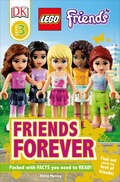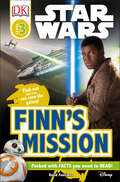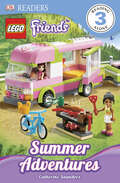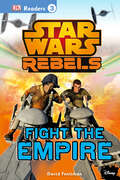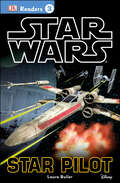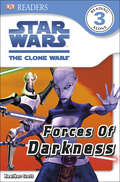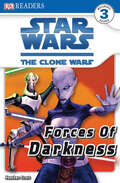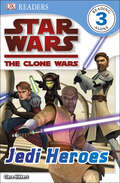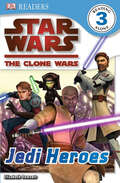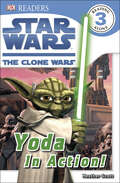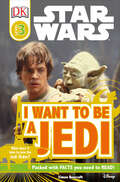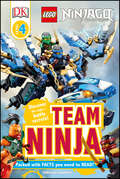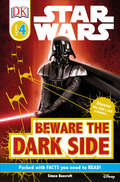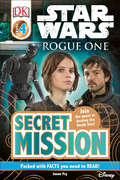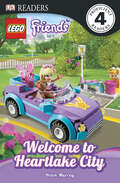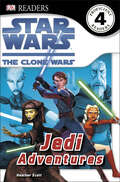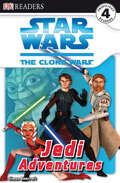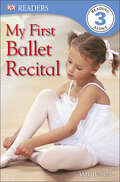- Table View
- List View
DK Readers L3: Find Out About the Best of Friends! (DK Readers Level 3)
by Helen MurrayGo on a reading adventure with the LEGO® Friends!Meet Olivia and her best friends Mia, Emma, Andrea, and Stephanie. Explore their beautiful home, Heartlake City, and enjoy many adventures along the way!Engaging topics and fun, interactive pages build reading skills in this Level 3 Reader – just right for children who are beginning to read on their own. A fun quiz at the end of the book helps to develop reading comprehension skills. Each title in the DK Readers series is developed in consultation with leading literacy experts to help children build a lifelong love of reading.©2012 The LEGO Group.
DK Readers L3: Find Out About the Best of Friends! (DK Readers Level 3)
by Helen MurrayGo on a reading adventure with the LEGO® Friends!Meet Olivia and her best friends Mia, Emma, Andrea, and Stephanie. Explore their beautiful home, Heartlake City, and enjoy many adventures along the way!Engaging topics and fun, interactive pages build reading skills in this Level 3 Reader – just right for children who are beginning to read on their own. A fun quiz at the end of the book helps to develop reading comprehension skills. Each title in the DK Readers series is developed in consultation with leading literacy experts to help children build a lifelong love of reading.©2012 The LEGO Group.
DK Readers L3: Find Out How Finn Can Save the Galaxy! (DK Readers Level 3)
by David FentimanJoin Finn as he faces the might of the evil First Order in DK Readers L3: Star Wars™: Finn's Mission.From the desert wastelands of Jakku to the jungles of D'Qar and the frozen mountains of the Starkiller, follow Finn as he bravely battles the First Order. Meet the heroes who will help him in his mission, and face the terrifying enemies who will stand in his way.Perfect for 7–9 year olds starting to read alone, Level 3 titles include in-depth information presented through more complex sentence structure with increasing amount of text to expand the reader's general knowledge and confidence in reading. Additional information spreads are full of extra facts, developing the topics through a range of nonfiction presentation styles, such as fliers, instructions, and record-breaker statistics.Fountas and Pinnell Text Level Gradient: TTrusted by parents, teachers, and librarians, and loved by kids, DK's leveled reading series is now revised and updated. With shiny new jackets and brand new nonfiction narrative content on the topics kids love, each book is written and reviewed by literacy experts, and contains a glossary and index making them the perfect choice for helping develop strong reading habits for kids ages 3–11.© & TM 2016 LUCASFILM LTD. Used Under Authorization.
DK Readers L3: Find Out How Finn Can Save the Galaxy! (DK Readers Level 3)
by David FentimanJoin Finn as he faces the might of the evil First Order in DK Readers L3: Star Wars™: Finn's Mission.From the desert wastelands of Jakku to the jungles of D'Qar and the frozen mountains of the Starkiller, follow Finn as he bravely battles the First Order. Meet the heroes who will help him in his mission, and face the terrifying enemies who will stand in his way.Perfect for 7–9 year olds starting to read alone, Level 3 titles include in-depth information presented through more complex sentence structure with increasing amount of text to expand the reader's general knowledge and confidence in reading. Additional information spreads are full of extra facts, developing the topics through a range of nonfiction presentation styles, such as fliers, instructions, and record-breaker statistics.Fountas and Pinnell Text Level Gradient: TTrusted by parents, teachers, and librarians, and loved by kids, DK's leveled reading series is now revised and updated. With shiny new jackets and brand new nonfiction narrative content on the topics kids love, each book is written and reviewed by literacy experts, and contains a glossary and index making them the perfect choice for helping develop strong reading habits for kids ages 3–11.© & TM 2016 LUCASFILM LTD. Used Under Authorization.
DK Readers L3: LEGO® Friends: Summer Adventures (DK Readers Level 3)
by Catherine SaundersEnjoy a summer of fun in Heartlake City!School is out for summer. Join Emma, Mia, Andrea, Stephanie, Olivia, and friends as they explore Heartlake City.Engaging topics and fun, interactive pages build reading skills in this Level 3 Reader – just right for children who are beginning to read on their own. Each title in the DK Readers series is developed in consultation with leading literacy experts to help children build a lifelong love of reading.©2013 The LEGO Group.
DK Readers L3: LEGO® Friends: Summer Adventures (DK Readers Level 3)
by Catherine SaundersEnjoy a summer of fun in Heartlake City!School is out for summer. Join Emma, Mia, Andrea, Stephanie, Olivia, and friends as they explore Heartlake City.Engaging topics and fun, interactive pages build reading skills in this Level 3 Reader – just right for children who are beginning to read on their own. Each title in the DK Readers series is developed in consultation with leading literacy experts to help children build a lifelong love of reading.©2013 The LEGO Group.
DK Readers L3: Star Wars Rebels Fight the Empire (DK Readers Level 3)
by David FentimanCould you stand up to the mighty Empire? Have you got what it takes to become a rebel? Learn all about the daring adventures of the crew of the Ghost, and their heroic struggle to free the galaxy in DK's newest Level 3 Reader Star Wars Rebels: Fight the Empire!
DK Readers L3: Star Wars: Star Pilot (DK Readers Level 3)
by Laura Buller Tori KosaraDK Reader Level 3: Star Wars®: Star Pilot features a lively, fact-packed narrative about the spaceships and vehicles of Star Wars. What is the biggest spaceship? What is a Jedi starfighter? This exciting book has all the answers!Level 3 is for children able to read on their own. The stories are exciting and captivating in order to develop the child's own desire to read. More text and more complex sentence structure are presented, with information spreads to help develop the reader's general knowledge. The choice of subject widens to match the broadening of children's experiences and interests.© & TM 2015 LUCASFILM LTD.
DK Readers L3: Star Wars: Star Pilot (DK Readers Level 3)
by Laura Buller Tori KosaraDK Reader Level 3: Star Wars®: Star Pilot features a lively, fact-packed narrative about the spaceships and vehicles of Star Wars. What is the biggest spaceship? What is a Jedi starfighter? This exciting book has all the answers!Level 3 is for children able to read on their own. The stories are exciting and captivating in order to develop the child's own desire to read. More text and more complex sentence structure are presented, with information spreads to help develop the reader's general knowledge. The choice of subject widens to match the broadening of children's experiences and interests.© & TM 2015 LUCASFILM LTD.
DK Readers L3: Star Wars: The Clone Wars: Forces of Darkness (DK Readers Level 3)
by Heather ScottIn Star Wars: The Clone Wars Reader Level 3: Forces Of Darkness, As Anakin masters his skills as a Jedi, the dark side calls to him. Can his respect for Obi-Wan or his love for Padmé save him? © 2008 Lucasfilm Ltd. ® & TM
DK Readers L3: Star Wars: The Clone Wars: Forces of Darkness (DK Readers Level 3)
by Heather ScottIn Star Wars: The Clone Wars Reader Level 3: Forces Of Darkness, As Anakin masters his skills as a Jedi, the dark side calls to him. Can his respect for Obi-Wan or his love for Padmé save him? © 2008 Lucasfilm Ltd. ® & TM
DK Readers L3: Star Wars: The Clone Wars: Jedi Heroes (DK Readers Level 3)
by Clare HibbertDK Readers team up with Star Wars and Star Wars: The Clone Wars yet again to get Padawans excited to read! Perfect for reluctant readers as well as devoted Star Wars and Star Wars: The Clone Wars fans, DK's Star Wars Readers have sold over 2.5 million units! Jedi Heroes follows the adventures of Anakin and his Jedi companions, including some all-new characters from Season 2 of Star Wars: The Clone Wars! (c) 2010 Lucasfilm Ltd. and TM. All Rights Reserved. Used Under Authorization.
DK Readers L3: Star Wars: The Clone Wars: Jedi Heroes (DK Readers Level 3)
by Clare HibbertDK Readers team up with Star Wars and Star Wars: The Clone Wars yet again to get Padawans excited to read! Perfect for reluctant readers as well as devoted Star Wars and Star Wars: The Clone Wars fans, DK's Star Wars Readers have sold over 2.5 million units! Jedi Heroes follows the adventures of Anakin and his Jedi companions, including some all-new characters from Season 2 of Star Wars: The Clone Wars! (c) 2010 Lucasfilm Ltd. and TM. All Rights Reserved. Used Under Authorization.
DK Readers L3: Star Wars: The Clone Wars: Yoda in Action! (DK Readers Level 3)
by Heather ScottTaking place between the last two Star Wars® films, Episode II: Attack of the Clones and Episode III: Revenge of the Sith, the Clone Wars fill a dark period in the history of the Galaxy. DK and Lucasfilm celebrate the all-new computer-generated animated series that will launch theatrically in August 2008 with three new Clone Wars titles. Now young readers can experience more Jedi action, more villainous battles, more weapons, more imagery, more fun, and more excitement! The awesome power of Yoda explodes in Star Wars®: The Clone Wars™ Reader Level 3: Yoda in Action! © 2008 Lucasfilm Ltd. ® & TM
DK Readers L3: What Does It Take to Join the Jedi Order? (DK Readers Level 3)
by Ryder Windham Simon BeecroftStar Wars DK Readers help kids learn to read while enjoying the stories and characters from the Star Wars universe. In I Want to Be a Jedi, find out what it takes to join the ranks of the Jedi - learn where the Jedi Academy is located, what the Jedi Code is, and how the Jedi fight with lightsabers.Level 3 Star Wars DK Readers are for children able to read on their own. Focusing on developing the child's own desire to read, the text is faster and the stories exciting and captivating. The Star Wars stories feature more text and more complex sentence structure, with information boxes to help develop the reader's general knowledge. The choice of subject widens to match the broadening of children's experiences and interests.Packed with full-color photographs and engaging, age-appropriate stories, Star Wars DK Reader ebooks introduce young children to a life-long love of reading. These amazing stories of the Star Wars universe are guaranteed to capture children's interest while developing their reading skills. Star Wars DK Readers are also perfect for reading together!© 2013 Lucasfilm Ltd. & TM
DK Readers L3: What Does It Take to Join the Jedi Order? (DK Readers Level 3)
by Ryder Windham Simon BeecroftStar Wars DK Readers help kids learn to read while enjoying the stories and characters from the Star Wars universe. In I Want to Be a Jedi, find out what it takes to join the ranks of the Jedi - learn where the Jedi Academy is located, what the Jedi Code is, and how the Jedi fight with lightsabers.Level 3 Star Wars DK Readers are for children able to read on their own. Focusing on developing the child's own desire to read, the text is faster and the stories exciting and captivating. The Star Wars stories feature more text and more complex sentence structure, with information boxes to help develop the reader's general knowledge. The choice of subject widens to match the broadening of children's experiences and interests.Packed with full-color photographs and engaging, age-appropriate stories, Star Wars DK Reader ebooks introduce young children to a life-long love of reading. These amazing stories of the Star Wars universe are guaranteed to capture children's interest while developing their reading skills. Star Wars DK Readers are also perfect for reading together!© 2013 Lucasfilm Ltd. & TM
DK Readers L4: Discover the Ninja's Battle Secrets! (DK Readers Level 4)
by Catherine SaundersJoin Cole, Jay, Kai, Zane, and Nya in their latest adventure across the exciting land of Ninjago. New enemies are rising—does the team have what it takes to defeat them?LEGO® NINJAGO™: Team Ninja features brand-new LEGO NINJAGO 2016 minifigures and sets. Jump straight into the heart of the action as Sensei Wu's brave pupils embark on an epic new adventure. Combining DK's four-level reading scheme with the popular LEGO NINJAGO theme, LEGO NINJAGO: Team Ninja is at Level 4 and will help kids learn to read—and to love reading.Perfect for 9–11 year olds reading independently, reading becomes a fact-discovering adventure with these Level 4 readers. Supporting and encouraging a lifetime love of reading, nonfiction subjects are clearly explained, described vividly, and brought to life with true encounters, fascinating statistics, and dramatic photographic images. Additional information spreads are full of extra fun facts, developing the topics through a range of nonfiction presentation styles, such as articles, journals, and timelines.Fountas and Pinnell Text Level Gradient: STrusted by parents, teachers, and librarians, and loved by kids, DK's leveled reading series is now revised and updated. With shiny new jackets and brand new nonfiction narrative content on the topics kids love, each book is written and reviewed by literacy experts, and contains a glossary and index making them the perfect choice for helping develop strong reading habits for kids ages 3–11.LEGO, the LEGO logo, the Brick and Knob configuration, the Minifigure, NINJAGO and the NINJAGO logo are trademarks of the LEGO Group. ©2016 The LEGO Group. All rights reserved. Produced by DK Publishing under license of the LEGO Group.
DK Readers L4: Discover the Sith's Evil Schemes . . . (DK Readers Level 4)
by Simon BeecroftDK's Star Wars Readers help kids learn to read while enjoying the stories and characters from the blockbuster movies. In Beware the Dark Side, take a bone-chilling trip to the dark side of the Force and meet the Sith who wield its power - Darth Sidious, Darth Maul, and the infamous Darth Vader. Packed with full-color photographs and engaging, age-appropriate stories, the ebooks introduce young children to a life-long love of reading. These amazing stories are guaranteed to capture children's interest while developing their reading skills. They're also perfect for reading together!© 2012 Lucasfilm Ltd.
DK Readers L4: Discover the Sith's Evil Schemes . . . (DK Readers Level 4)
by Simon BeecroftDK's Star Wars Readers help kids learn to read while enjoying the stories and characters from the blockbuster movies. In Beware the Dark Side, take a bone-chilling trip to the dark side of the Force and meet the Sith who wield its power - Darth Sidious, Darth Maul, and the infamous Darth Vader. Packed with full-color photographs and engaging, age-appropriate stories, the ebooks introduce young children to a life-long love of reading. These amazing stories are guaranteed to capture children's interest while developing their reading skills. They're also perfect for reading together! The playful images in this eBook are enhanced with entertaining animations and surprising sounds to bring this story to life. © 2012 Lucasfilm Ltd.
DK Readers L4: Join the Quest to Destroy the Death Star! (DK Readers Level 4)
by Jason FryDK Reader L4: Star Wars Rogue One™ combines DK's four-level reading scheme with the exciting box office record-breaking Star Wars™ movies. DK Readers help kids learn to love reading.Perfect for 9–11 year olds reading independently, reading becomes a fact-discovering adventure with these Level 4 readers. Supporting and encouraging a lifetime love of reading, nonfiction subjects are clearly explained, described vividly, and brought to life with true encounters, fascinating statistics, and dramatic photographic images. Additional information spreads are full of extra fun facts, developing the topics through a range of nonfiction presentation styles, such as articles, journals, and timelines.Trusted by parents, teachers, and librarians, and loved by kids, DK's leveled reading series is now revised and updated. With new jackets and brand new nonfiction narrative content on the topics kids love, each book is written and reviewed by literacy experts, and contains a glossary and index making them the perfect choice for helping develop strong reading habits for kids ages 3–11.
DK Readers L4: LEGO Friends: Welcome to Heartlake City (DK Readers Level 4)
by Helen MurrayGo on a reading adventure with the LEGO® Friends!Come explore Heartlake City with Emma, Mia, Andrea, Stephanie, and Olivia. Take a tour of the amazing places in Heartlake City and meet some of the adorable animals that live there.Engaging topics and fun, interactive pages build reading skills in this Level 4 Reader – just right for children who can read alone. A fun quiz at the end of the book helps to develop reading comprehension skills. Each title in the DK Readers series is developed in consultation with leading literacy experts to help children build a lifelong love of reading.©2012 The LEGO Group.
DK Readers L4: LEGO Friends: Welcome to Heartlake City (DK Readers Level 4)
by Helen MurrayGo on a reading adventure with the LEGO® Friends!Come explore Heartlake City with Emma, Mia, Andrea, Stephanie, and Olivia. Take a tour of the amazing places in Heartlake City and meet some of the adorable animals that live there.Engaging topics and fun, interactive pages build reading skills in this Level 4 Reader – just right for children who can read alone. A fun quiz at the end of the book helps to develop reading comprehension skills. Each title in the DK Readers series is developed in consultation with leading literacy experts to help children build a lifelong love of reading.©2012 The LEGO Group.
DK Readers L4: Star Wars: The Clone Wars: Jedi Adventures (DK Readers Level 4)
by Simon BeecroftTaking place between the last two Star Wars® films, Episode II: Attack of the Clones and Episode III: Revenge of the Sith, the Clone Wars fill a dark period in the history of the Galaxy. DK and Lucasfilm celebrate the all-new computer-generated animated series that will launch theatrically in August 2008 with three new Clone Wars titles. Now young readers can experience more Jedi action, more villainous battles, more weapons, more imagery, more fun, and more excitement! Join the Jedi Knights on daring adventures throughout the galaxy in Star Wars®: The Clone Wars™ Reader Level 4: Jedi Adventures. © 2008 Lucasfilm Ltd. ® & TM
DK Readers L4: Star Wars: The Clone Wars: Jedi Adventures (DK Readers Level 4)
by Simon BeecroftTaking place between the last two Star Wars® films, Episode II: Attack of the Clones and Episode III: Revenge of the Sith, the Clone Wars fill a dark period in the history of the Galaxy. DK and Lucasfilm celebrate the all-new computer-generated animated series that will launch theatrically in August 2008 with three new Clone Wars titles. Now young readers can experience more Jedi action, more villainous battles, more weapons, more imagery, more fun, and more excitement! Join the Jedi Knights on daring adventures throughout the galaxy in Star Wars®: The Clone Wars™ Reader Level 4: Jedi Adventures. © 2008 Lucasfilm Ltd. ® & TM
DK Readers: My First Ballet Recital (DK Readers Level 3)
by DK Amy JunorThe DK Reader My First Ballet Recital is the story of a girl's preparation for her first ballet performance, where she and her classmates can show off all they've learned! Packed with full-color photographs, lively illustrations, and engaging, age-appropriate stories to introduce young children to a life-long love of reading. These amazing stories are guaranteed to capture children's interest while developing their reading skills. Perfect for reading together! The playful images in this eBook are enhanced with entertaining animations and surprising sounds to bring this story to life.
